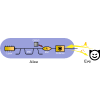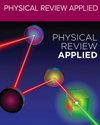对真实世界量子密钥分发系统的木马攻击:理论与实验安全分析
IF 4.4
2区 物理与天体物理
Q2 PHYSICS, APPLIED
引用次数: 0
摘要
本文从理论和实验两方面论证了对真实世界量子密钥分发(QKD)系统的木马攻击(THA)的安全性分析。我们证明,信息泄漏的上限完全取决于对手状态之间的保真度。考虑到纯态和混合态,我们找到了极化和相位编码 BB84 协议中 THA 状态间保真度的下限。我们的界限只取决于对手每个脉冲可用的平均光子数。我们还介绍了 QKD 系统的实验分析,包括厘米级分辨率的光学时域反射测量,以及 1100 到 1800 nm 范围内光学防御元件的光谱透射测量,其噪声本底低于 -100 dB。最后,通过考虑最优攻击,我们获得了对手可利用的每个脉冲平均光子数的值,并计算出在隐私放大过程中需要消除的密钥泄漏。本文章由计算机程序翻译,如有差异,请以英文原文为准。

Trojan-horse attack on a real-world quantum key distribution system: Theoretical and experimental security analysis
This paper presents a theoretical and experimental demonstration of a security analysis of a Trojan-horse attack (THA) on a real-world quantum key distribution (QKD) system. We show that the upper bound on the information leakage depends solely on the fidelity between the states of the adversary. We find the lower bound for fidelity between THA states in both the polarization- and phase-coding BB84 protocols, considering both pure and mixed states. Our bounds depend only on the mean photon number per pulse available to an adversary. We also present an experimental analysis of a QKD system, including optical time-domain reflectometry measurements with centimeter resolution and spectral transmittance measurements for optical defense elements ranging from 1100 to 1800 nm with a noise floor lower than dB. Finally, by considering the optimal attack, we obtain the value of the mean photon number per pulse available to an adversary and calculate the key leakage that needs to be eliminated during the privacy amplification procedure.
求助全文
通过发布文献求助,成功后即可免费获取论文全文。
去求助
来源期刊

Physical Review Applied
PHYSICS, APPLIED-
CiteScore
7.80
自引率
8.70%
发文量
760
审稿时长
2.5 months
期刊介绍:
Physical Review Applied (PRApplied) publishes high-quality papers that bridge the gap between engineering and physics, and between current and future technologies. PRApplied welcomes papers from both the engineering and physics communities, in academia and industry.
PRApplied focuses on topics including:
Biophysics, bioelectronics, and biomedical engineering,
Device physics,
Electronics,
Technology to harvest, store, and transmit energy, focusing on renewable energy technologies,
Geophysics and space science,
Industrial physics,
Magnetism and spintronics,
Metamaterials,
Microfluidics,
Nonlinear dynamics and pattern formation in natural or manufactured systems,
Nanoscience and nanotechnology,
Optics, optoelectronics, photonics, and photonic devices,
Quantum information processing, both algorithms and hardware,
Soft matter physics, including granular and complex fluids and active matter.
 求助内容:
求助内容: 应助结果提醒方式:
应助结果提醒方式:


